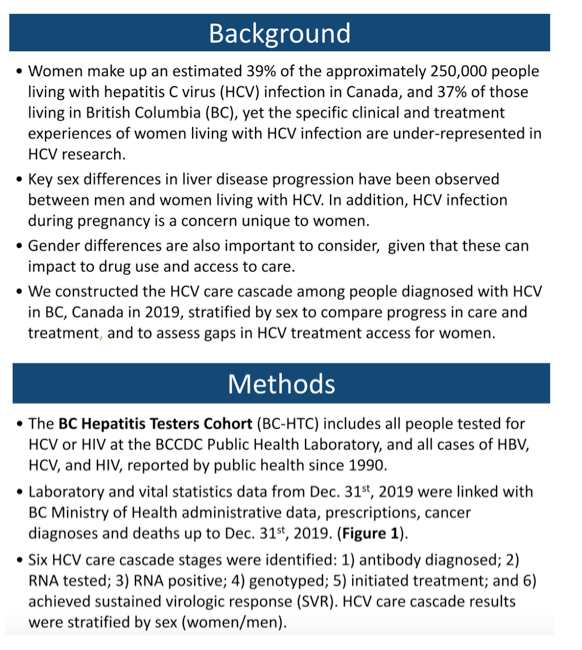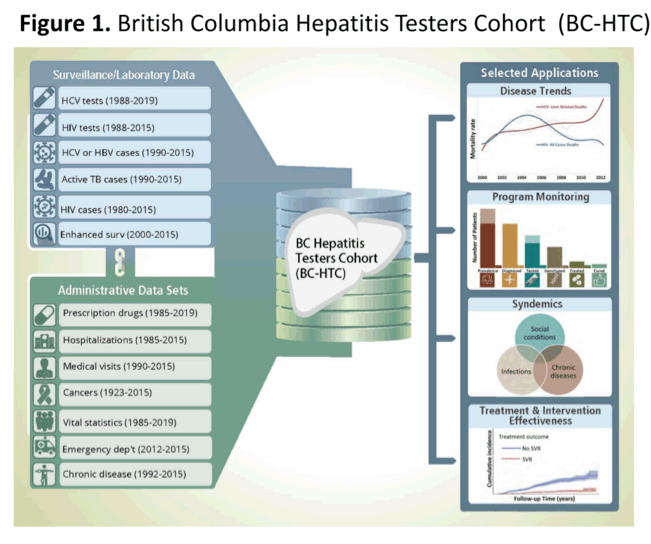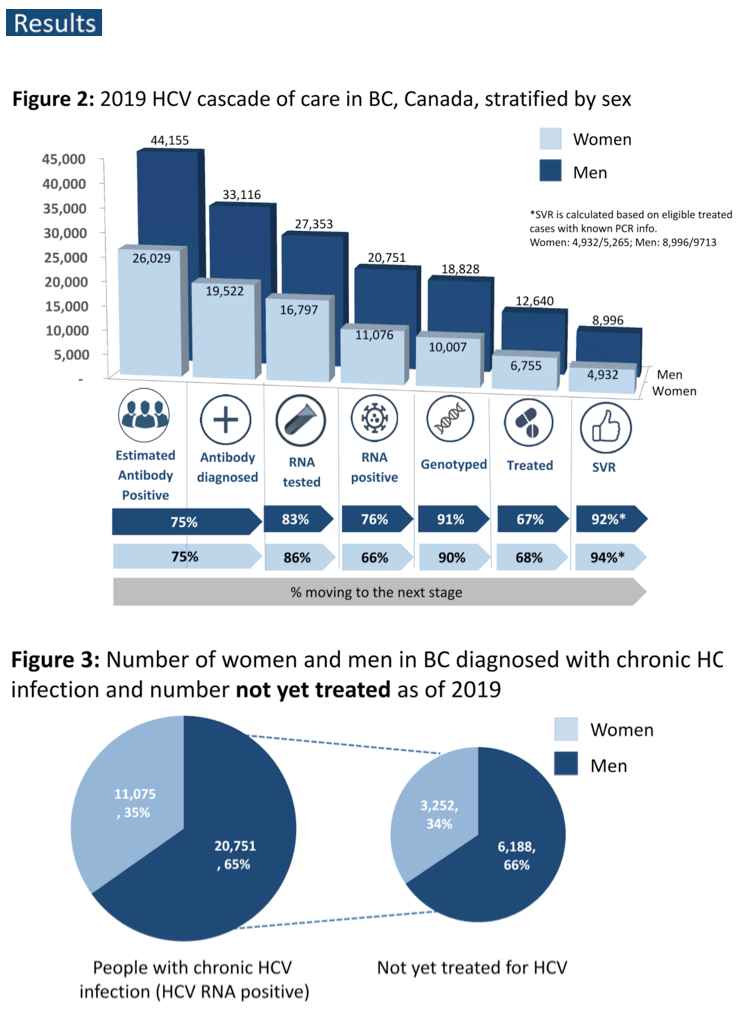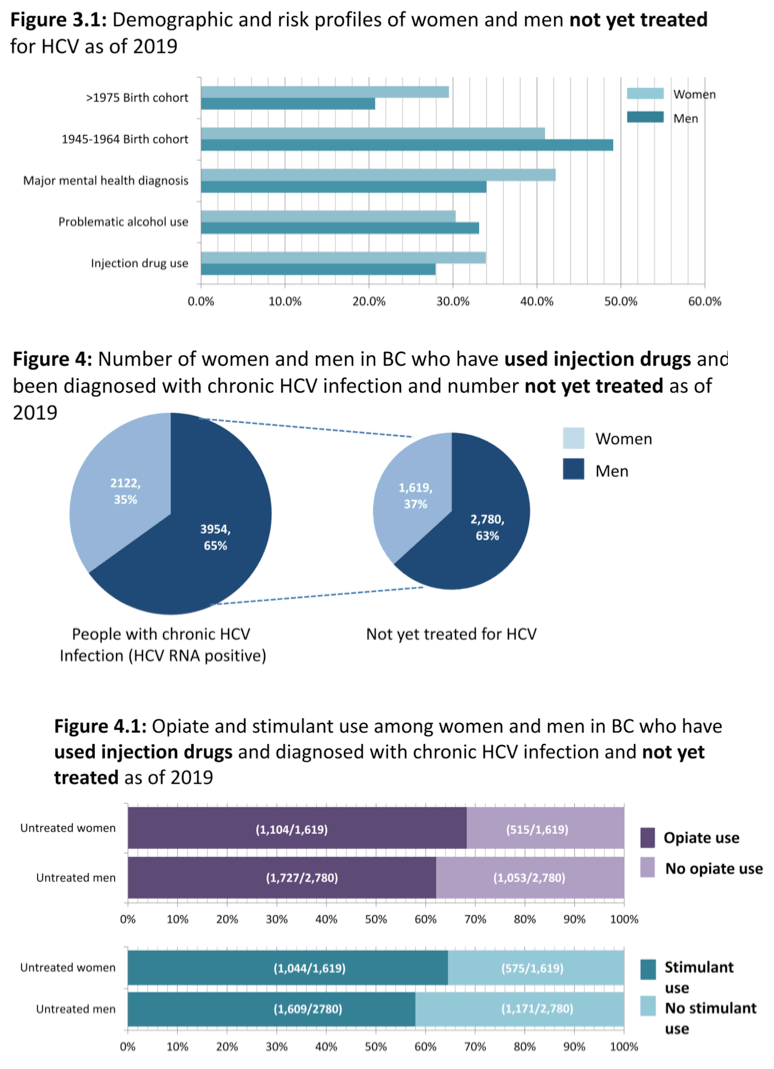 |
 |
 |
| |
WOMEN AND THE 2019 HEPATITIS C CASCADE OF CARE:
FINDINGS FROM THE BC-HEPATITIS TESTERS COHORT
|
| |
| |
Prenatal care is the health care you get while you are pregnant. The postnatal period can be defined as the first 6-8 weeks after birth.
to improve treatment access, HCV care providers may consider adopting trauma-informed and culturally safe approaches to meet the needs of younger women of childbearing age, those with mental health diagnoses, and women who use drugs...... higher proportions of women compared to men were born after 1975 had a mental health diagnosis and had used injection drugs. Among 1,619 women and 2,780 men who had used injection drugs and were not yet treated, higher proportions of women than men used stimulants (64 .5% vs . 57 .9%, p<0 .001), and opiates.
AASLD 2020 Nov 11-16
Margo Pearce1,2, Amanda Yu2, Sofia Bartlett3, Mawuena Binka1,2, Hector Velasquez4, James Wilton4, Maryam Darvishian5, Prince Adu2, Dahn Jeong4, Emilia Clementi1, Younathan Abdia1, Hasina Samji1,6, Maria Alvarez2, Stanley Wong2, Eric M. Yoshida7,8, Neora Pick9, Mel Krajden1,2 and Naveed Janjua2,10, (1)BC Centre for Disease Control, (2)British Columbia Centre for Disease Control, (3)University of British Columbia, (4)Bccdc, (5)British Columbia Cancer Agency, (6)Faculty of Health Sciences, Simon Fraser University, (7) Gastroenterology, University of British Columbia, (8)Medicine, University of British Columbia, (9)BC Women's Hospital, (10) School of Population and Public Health, University of British Columbia
Background: In Canada, women make up ∼39% of the approximately 250,000 people living with hepatitis C (HCV) and may be overrepresented within key populations requiring additional support to access HCV care and curative treatment . We constructed the HCV care cascade among people diagnosed with HCV in British Columbia (BC), Canada in 2019, stratified by male/female gender to compare progress in care and treatment and to assess gaps in HCV treatment access for women.
Methods: The BC Hepatitis Testers Cohort includes 1 .7 million people who tested for HCV, HIV, reported cases of hepatitis B, and active tuberculosis in BC from 2000-2019 . Test results were linked to medical visits, hospitalizations, cancers, prescription drugs, and mortality data. Six HCV care cascade stages were identified: 1) antibody diagnosed; 2) RNA tested; 3) RNA positive; 4) genotyped; 5) initiated treatment; and 6) achieved sustained virologic response (SVR). HCV care cascade results were stratified by gender.
Results: In 2019, 52,638 people were diagnosed anti-HCV positive in BC; among those, 37.1% (19,522) were women. Women and men had similar progress through each step of the HCV care cascade (Figure 1). The proportion of anti-HCV positive women receiving a confirmatory RNA test was 86% (16,797/19,522) compared to 82 .6% (27,353/33,116) of men. Thirty-four percent (5,721/16,797) of women RNA tested had negative results (spontaneously cleared) compared to 24.1% (6,602/27,353) of men. Among people who had been genotyped, 68% (6,756/10,008) of women and 67% (12,640/18,828) of men initiated treatment, with 94% (5,023/5,364) of women and 92% (9,147/9,897) of men achieving SVR.
Among the 3,252 women and 6,188 men not yet treated, higher proportions of women compared to men were born after 1975 (29 .5% vs . 20 .8%, p<0 .001), had a mental health diagnosis (42 .2% vs . 34%, p<0 .001) and had used injection drugs (49 .8% vs . 44 .9%, p<0 .001). Among 1,619 women and 2,780 men who had used injection drugs and were not yet treated, higher proportions of women than men used stimulants (64 .5% vs . 57 .9%, p<0 .001), and opiates (68 .2% vs . 62 .1%, p<0 .001).
Conclusion: HCV care and treatment services appear to be equally engaging women and men into the HCV care cascade . Nevertheless, to improve treatment access, HCV care providers may consider adopting trauma-informed and culturally safe approaches to meet the needs of younger women of childbearing age, those with mental health diagnoses, and women who use drugs.





|
| |
|
 |
 |
|
|